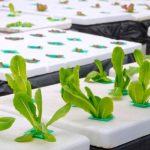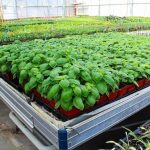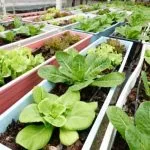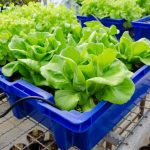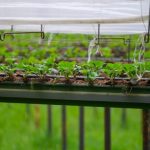Ebb and flow hydroponics systems, also called flood and drain systems, are an efficient and effective way to grow plants. By flooding the plants’ roots for a specific period and then draining the water away, you provide your plants with the required nutrients while allowing them to get the necessary oxygen. Implementing a suitable ebb and flow hydroponics watering schedule is essential to making the most of this method.
The ideal flood and drain timing for your hydroponics system depends on various factors, including the type of growing media you use, the size of your root system, and even the environment. For example, the Rockwool feed schedule suggests flooding and draining approximately 1 to 5 times per day, but this is just an approximation. Observing your system’s characteristics and adjusting accordingly is key to achieving the optimal watering schedule.

Remember that the goal is to keep your plants’ grow media moist but not soaked, so it’s essential to find the right balance between flooding and draining. Pay close attention to your plants’ behavior and adjust the schedule as needed to ensure they thrive.
Fundamentals of Ebb And Flow Hydroponics
Ebb and Flow, also known as Flood and Drain, is a popular choice among various hydroponic systems. It is recognized for its effectiveness and energy efficiency. As you set up your ebb and flow hydroponics system, it is important to become familiar with the basic concepts and key elements involved in it. So if you haven’t already, read our comprehensive guide on what ebb and flow hydroponics is.
Ebb and flow hydroponics consist of a grow tray, a reservoir, and a pump on a timer. The principle behind this system is to alternate the flooding and draining of the growing medium with a nutrient-rich solution. This enables your plant’s roots to receive optimal nutrition while promoting healthy aeration.
When it comes to flood and drain hydroponic system timing, there are several factors to consider, such as plant size, growing medium, and environmental conditions. While there is no one-size-fits-all formula, a general rule of thumb is to flood the grow tray for 15-30 minutes and allow the solution to drain completely before the next flood cycle. The duration between flood cycles can range from a few hours to several times a day, depending on your plant’s needs.
An ebb and flow hydroponic timer plays a crucial role in the success of your system. It automates the pump’s operation, ensuring that the flooding and draining occur at optimal intervals. A reliable timer not only helps in maintaining the necessary nutrient uptake for your plants but also conserves water and energy by preventing overwatering.
Selecting a suitable growing medium for your flood and drain system is essential as well. There are various options, such as coco coir, perlite, and clay pebbles. Each type offers different drainage properties, which affects the flood and drain times. Pick a medium that complements your plants’ requirements and adapt your watering schedule accordingly.
In summary, understanding the fundamentals of ebb and flow hydroponics will help you maintain an efficient and successful system. By optimizing the timing, selecting an appropriate growing medium, and employing a dependable timer, you’ll be well on your way to growing healthy and thriving plants.
Related: Want to know how to build an ebb and flow system? Learn from our DIY guide! Prefer convenience? Choose from our top picks of ebb and flow system kits.
Selecting The Right Growing Medium
When it comes to ebb and flow hydroponics watering schedule, choosing the right growing medium is crucial for your plants’ growth and health. These systems function well with porous and water-retentive growth media. In this section, we’ll cover two popular pairs of growing media that you can use in a 50/50 mix: Coconut Coir with Perlite, and Rockwool with Expanded Clay Pebbles.
Rockwool and Expanded Clay Pebbles
Rockwool is a popular hydroponic medium made from spun rock fibers. It has excellent water retention, making it suitable for ebb and flow systems. Your plants will need a feed schedule of 1 to 5 times per day when using Rockwool. However, keep in mind that Rockwool may require a thorough rinsing before use, as it has a high pH that needs to be adjusted.
Expanded Clay Pebbles are a lightweight, porous, and pH-neutral growing medium. They are made by heating clay to high temperatures, causing it to expand and become porous. One advantage of expanded clay pebbles is their ability to provide excellent drainage and aeration, allowing your plants’ roots to access oxygen, and preventing root rot. However, they have less water retention compared to other media, so you should combine it with a medium like Rockwool and adjust your flood and drain schedule accordingly.
Coconut Coir and Perlite
Coconut Coir, also referred to as coco coir, is another popular growing medium for hydroponic systems. It is made from the fibers found in coconut husks and has excellent water-holding capacity, air permeability, and natural antifungal properties. When using coco coir, you should water your plants every 3 to 5 hours, translating to about 3 to 5 times per day.
Perlite is a lightweight, white volcanic rock that can be easily crushed into a powder. It is preferred for its excellent drainage properties and air circulation, which helps prevent root rot. Perlite also has a neutral pH and is sterile, making it a good option for your ebb and flow system. To establish an appropriate watering schedule when using perlite, closely observe your plants and adjust the frequency based on their needs, as it has less water retention capacity.
Remember, selecting the right growing medium is crucial for your ebb and flow hydroponics system. Evaluate the specific requirements of your plants and choose the medium that best suits their needs to ensure healthy growth and a successful hydroponic garden.
Ebb and Flow Hydroponics Watering Schedule And Frequency
Growth Stage And Plant Size
In an ebb and flow setup, your watering schedule and frequency depend on the growth stage and plant size. During the germination stage, it’s essential to maintain a consistent flood cycle to ensure seedlings receive adequate moisture and access to nutrients. As your plants grow, you’ll need to adjust the watering schedule accordingly.

- Germination: Flood your system every 2 hours to ensure proper moisture levels.
- Vegetative stage: Flood 4 to 6 times a day, depending on plant size and water retention capacity of the growing medium.
- Flowering stage: You can reduce the flood cycle to 3 to 5 times a day, as the plants have a more established root system that can retain water better.
Please note that these are general guidelines, and the specific watering schedule for your system may vary based on factors such as growing medium, plant variety, and environmental conditions.
Environmental Factors And Maintenance
In addition to growth stage and plant size, environmental factors and maintenance play a crucial role in determining the hydroponic ebb and flow watering schedule.
- Temperature: Higher temperatures lead to increased evaporation, so you may need to increase the flood frequency depending on your growing environment.
- Humidity: In high humidity, plants tend to transpire less, which means they require less frequent flooding. Conversely, low humidity will require more frequent flooding.
- Aeration: Ensuring adequate aeration of the nutrient solution can help prevent overwatering problems. Oxygenation of the water allows roots to breathe, decreasing the frequency of flooding needed.
- Growing Medium: Different media have varying water retention capacities, requiring different flood frequencies. For example, coconut coir retains water better than rockwool, so you may need to adjust your watering schedule accordingly.
- Maintenance: Regularly check and maintain your ebb and flow system components, including water pumps, overflow drains, and trays, to prevent underwatering or overwatering issues.
Remember to always monitor your plants for signs of stress, such as wilting or yellowing leaves, as these can indicate under- or overwatering. Adjust your watering schedule as needed based on the health and needs of your plants, and don’t hesitate to make changes as required to ensure their optimal growth and development.
Related: How often to change water in ebb and flow systems depends a lot on other factors as described in our comprehensive guide.
You can also check out our guides on a drip system hydroponic watering cycle and a NFT watering cycle.
Nutrients And pH Management
Nutrient Solution And Deficiencies
In an Ebb and Flow hydroponics system, ensuring the right balance of nutrients and pH levels is crucial for your plants’ health and growth. To achieve this, you will need to prepare a nutrient solution by purchasing a micronutrient mix or water-soluble fertilizer and epsom salts. Follow the instructions on the package to mix the correct amount of fertilizer (usually around two teaspoons) with water, and then add one teaspoon of epsom salts per gallon of water. This nutrient solution will provide your plants with all the necessary elements for healthy growth.
However, it is essential to watch for any signs of nutrient deficiencies in your plants. Some common symptoms include:
- Yellowing leaves
- Stunted growth
- Curling or wilting leaves
If you notice any of these signs, you may need to adjust the nutrient solution to address the issue. Keep in mind that different plants have different nutrient requirements, so it’s essential to research the specific needs of the plants you are growing.
Monitoring And Adjusting pH Levels
Maintaining the proper pH level in your nutrient solution is key to ensuring your plants can absorb the nutrients they need. The ideal pH range for most hydroponic systems is between 5.5 and 6.5. You can track your pH levels by using pH testing strips or a digital pH meter, which will give you a more accurate reading.
If your pH levels are outside of the recommended range, you can make adjustments using pH-up or pH-down solutions. To adjust the pH, add small amounts of the solution to the water and mix well before retesting the pH. Repeat this process until the desired pH range is achieved. It’s crucial to monitor pH levels regularly to maintain a stable environment for your plants.
Proper nutrients and pH management are essential factors affecting plant growth in an Ebb and Flow hydroponics system. By making sure your plants receive the required nutrition in the right pH range, you can ensure your plants grow strong, healthy, and productive.
Related: If you’re deciding whether to choose this system or another, learn about ebb and flow disadvantages and advantages first.
Troubleshooting And Tips For Success
In this section, we’ll discuss some common issues and provide helpful tips for maintaining a successful ebb and flow hydroponic watering system.
Preventing Root Rot And Disease
To prevent root rot and diseases in your ebb and flow system, follow these guidelines:
- Monitor water temperature: Keep the water in your system between 65°F and 70°F. Warmer water leads to lower oxygen levels, which can encourage the growth of bacteria and root rot.
- Use beneficial bacteria: Adding beneficial bacteria to your nutrient solution helps to break down organic matter, reducing the likelihood of disease. It can also help to increase the oxygen in the system.
- Clean your system regularly: Clear debris and sludge from your reservoir and growing medium to minimize the risk of infection.
Effective Flood And Drain System
To maintain an effective flood and drain system, consider these tips:
- Choose the right flood frequency: We have had the best results when we should flood our system 4 to 8 times a day for expanded clay pebbles and 3 to 5 times a day for coconut coir.
- Pump sizing: Ensure that your pump is the correct size for your system to deliver the right amount of water. A too-small pump can lead to insufficient nutrient delivery, while an oversized pump can cause problems like water splashing.
- Keep your timer in check: Make sure to set your timer for the appropriate flood and drain intervals to prevent your growing media from drying out between flooding cycles.
- Change your water: It’s a good practice to change the water in your ebb and flow system every 10 to 14 days. This helps to maintain a proper nutrient balance and prevents the buildup of harmful elements.
- Correct water level: Maintain the water level within 1-2 inches of the bottom of the net pot to ensure the roots receive enough oxygen.
By following these tips, you can help keep your ebb and flow hydroponic watering system running smoothly and successfully with healthy plant growth.

